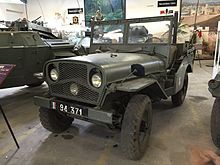Delahaye VLR
| Delahaye | |
|---|---|
|
Delahaye VLR as a rally participant
|
|
| VLR | |
| Production period: | 1949-1953 |
| Class : | Off-road vehicle |
| Body versions : | Kübelwagen |
| Engines: |
Otto engine : 2.0 liters (46 kW) |
| Length: | 3460 mm |
| Width: | 1630 mm |
| Height: | 1430-1850 mm |
| Wheelbase : | 2150 mm |
| Empty weight : | 1460 kg |
| successor | Hotchkiss M201 |
The Delahaye VLR is a four - wheel drive off - road vehicle that was specially developed for the French army from 1948 to replace the American Willys MB and the Ford GPW .
description
For the time, the Delahaye VLR (Véhicule de Liaison et de Reconnaissance Delahaye, French for liaison and reconnaissance vehicle) has technically very sophisticated design features . As with its role model, the Willys MB / Ford GPW , on which it is optically based, the body is open, without doors and has a fold-down windshield. Instead of four, it has five seats. The technical features are, for example, a fully synchronized four-speed transmission with optional reduction , adjustable torsion bar suspension for each wheel, differential locks on both axles, an aluminum -Motorblock with dry sump lubrication and 24 volts -Elektrik. In the French army , the VLR was mainly used as a liaison, command and radio vehicle.
history
The VLR was presented in 1949 by the French automobile manufacturer Delahaye for testing purposes and was intended to replace the American Jeep (Willys MB or Ford GPW). The first prototypes were tested between 1949 and 1950 and, after some design changes, were finally accepted by the army in 1951. The vehicle received the designation VLRD (Voiture Légère de Reconnaissance Delahaye - 1951 model).
However, the technically complex solutions described above turned out to be problematic in practice. Since the troops could not wait enough for the complicated technology, there were frequent failures. In addition, there were accidents that were caused by mostly poorly trained drivers who were overwhelmed by such a high-performance off-road vehicle.
After various unsuccessful attempts to get these problems under control through further technical changes (in the 1953 model, for example, the differential locks and their operation were completely redesigned), the army refused to order further vehicles in 1954. Instead, the decision was made to keep the jeeps from war stocks and to commission the Hotchkiss company with the production of new M201 vehicles .
This step brought Delahaye into great financial difficulties and in the same year ultimately led to the merger with Hotchkiss to form Société Hotchkiss-Delahaye , which in turn meant the end of Delahaye as an automobile manufacturer.
A total of only 9,623 Delahaye SUVs were produced, most of them as military VLRDs, but also some as civilian 12-volt versions, the VLRC-12. This civil version turned out to be far too expensive to be successful against the cheap war jeeps that were still available in large numbers.
Technical specifications
| Technical data Delahaye VLR | ||
|---|---|---|
| Empty weight | 1460 kg | |
| Payload | 400 kg | |
| Trailer load | 750 kg (unbraked) | |
| width | 1630 mm | |
| length | 3460 mm | |
| Height (with hood) | 1850 mm | |
| Height (windshield folded down) | 1430 mm | |
| wheelbase | 2150 mm | |
| Top speed | 105 km / h | |
| Ground clearance | 340 mm | |
| Climbing ability | 70% | |
| Approach angle at the front | 57 ° | |
| Departure angle at the rear | 42 ° | |
| Fording depth | 600 mm | |
| engine | Four-stroke - gasoline engine , 4 cylinders in series , OHV | |
| Displacement | 1992 cc | |
| power | 63 hp / 46 kW | |
| Seats | 5 | |

